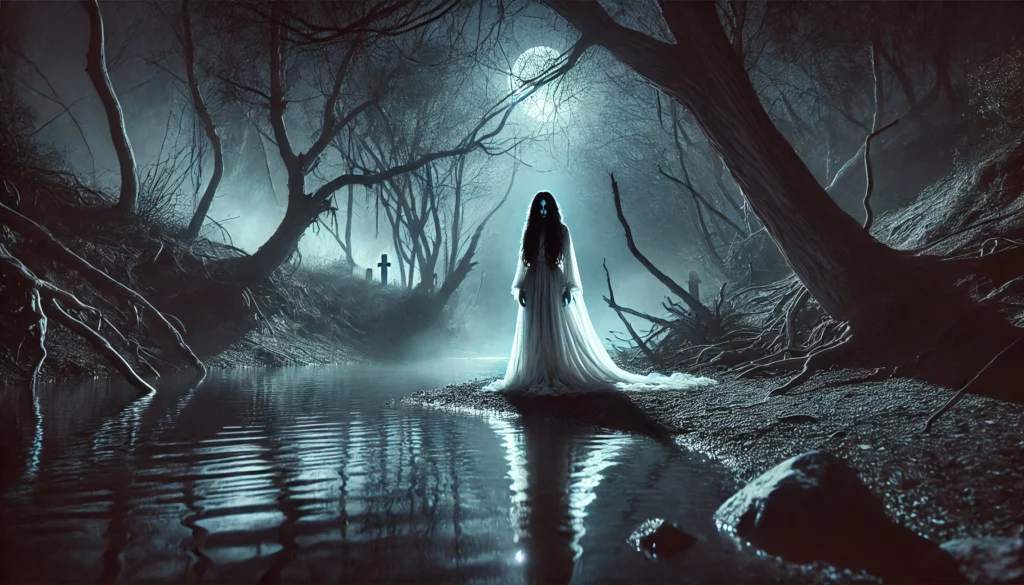In the moonlit streets and quiet rivers of Latin America, the legend of La Llorona, or “The Weeping Woman,” resonates through generations. Known for her haunting cries and tragic tale, La Llorona is one of the most enduring figures in Latin American folklore. Her story, filled with sorrow, betrayal, and punishment, has captivated and terrified communities for centuries. Let’s explore the origins, symbolism, and cultural impact of La Llorona, delving into why this legend endures and continues to evoke both fear and fascination.
The Origins of La Llorona
La Llorona’s tale is rooted in Mexican and Latin American folklore, with variations of the story told across different regions. Most versions agree on the basic plot: La Llorona was a beautiful woman named María who fell in love with a wealthy man and had children with him. However, when he abandoned her or rejected her for another, her jealousy and heartbreak led her to a horrific act. In a fit of rage or sorrow, María drowned her children in a river. Realizing what she had done, she was consumed by grief and remorse, wandering along the riverbanks in search of her lost children. Eventually, she drowned herself and was cursed to roam the earth as a ghost, crying out for her children and warning others to avoid her tragic fate.
The earliest written accounts of La Llorona date back to the Spanish colonial period, but some believe her story has deeper, pre-Hispanic roots. Dr. Jesús Garcia, a Latin American historian, argues that La Llorona could be connected to the Aztec goddess Cihuacóatl, a deity associated with motherhood, birth, and death. According to Aztec lore, Cihuacóatl would sometimes appear as a weeping woman, crying for her children and foreshadowing tragedy (Garcia, Folklore and Tradition in Mesoamerican Mythology, 2001). This connection suggests that La Llorona may embody themes from both Indigenous and colonial influences.
Symbolism of La Llorona: Motherhood, Sorrow, and Consequence
La Llorona’s story carries multiple layers of symbolism, making her a powerful figure of warning, grief, and the consequences of human actions.
The Symbolism of Motherhood and Loss: La Llorona represents the darker aspects of motherhood, the grief, sacrifice, and sometimes overwhelming despair. In her ghostly form, she is a mother who mourns the loss of her children, symbolizing the pain of losing what one loves most. Dr. Ana Morales, a folklorist, suggests that La Llorona’s endless search for her children reflects the universal fears of abandonment and separation (Morales, Mothers of Myth and Legend, 2004). Her cries resonate deeply with the emotions surrounding motherhood and loss.
Consequences and Punishment: La Llorona’s story serves as a moral tale, warning against the dangers of jealousy, impulsive actions, and the ultimate consequences of tragic decisions. Her punishment—an eternity of wandering, mourning, and seeking redemption—is a cautionary lesson on the irreversible nature of certain choices. Her story emphasizes that unchecked emotions can lead to irreversible harm, both to oneself and to others.
The Liminal Space of Ghosts and Transformation: As a ghostly figure, La Llorona exists in a liminal space between life and death, unable to find peace due to her actions. Her haunting presence at rivers and waterways is a reminder of the threshold between the living and the dead. Many stories claim that hearing La Llorona’s cries or seeing her ghost can bring bad luck or even death, reinforcing her role as a harbinger of tragedy and a reminder of the ever-present connection between past actions and future consequences.
La Llorona in Modern Culture
The story of La Llorona has become a staple in Latin American culture, inspiring countless retellings, adaptations, and artistic works. In Mexico and beyond, parents often use La Llorona as a cautionary figure to deter children from wandering too far from home, warning that “La Llorona will come for you.” Her story has been adapted into literature, music, and film, most notably in the 2019 horror movie The Curse of La Llorona, which introduced her legend to a global audience.
While some adaptations portray her as a vengeful spirit, others depict her with a more sympathetic, tragic tone, emphasizing her sorrow over her malevolence. This duality captures the complexity of her story—she is a victim of her own decisions and yet a villain in her own right, doomed by her actions but also mournful and regretful. In this way, La Llorona is often depicted as both feared and pitied, her sorrow reminding us of the heavy weight of regret and the yearning for redemption.
Scientific Interpretations and the Power of Belief
Like many supernatural legends, some researchers have attempted to interpret La Llorona’s story through psychological and cultural lenses. Folklorists believe that La Llorona may reflect collective fears and social warnings, particularly about family loyalty and moral behavior. Sociologists, such as Dr. Pedro Gomez, argue that La Llorona’s story provides a “safe space” for exploring the anxieties surrounding motherhood, abandonment, and tragedy, allowing communities to confront these fears symbolically (Gomez, Cultural Archetypes in Latin American Lore, 2009).
Psychologists suggest that La Llorona’s legend may also be a manifestation of cultural guilt and regret, particularly around themes of family and loss. The persistence of her story illustrates the power of shared narratives, showing how folklore can shape and reflect community values. The fear and respect people hold for La Llorona emphasize the importance of storytelling in understanding and expressing complex emotions.
La Llorona’s Enduring Impact: A Cultural Ghost Story
Despite scientific explanations, La Llorona remains an influential figure in Latin American folklore. Many still believe in her ghostly presence, sharing sightings and personal encounters that add to her legacy. In communities across Latin America, La Llorona’s cries are believed to echo along rivers and lakes, a haunting reminder of the past and the spectral boundary between life and death.
La Llorona’s tale continues to evolve, adapting to new forms of storytelling and inspiring artists, writers, and filmmakers worldwide. Her story endures not just because of its supernatural elements but because it speaks to universal themes of love, loss, and redemption. La Llorona’s story is not only a ghostly warning but also a cultural bridge, connecting past to present and illustrating the profound impact of folklore in shaping our understanding of the human experience.
Final Thoughts: La Llorona’s Legacy of Sorrow and Redemption
La Llorona’s tragic story serves as a haunting reminder of the choices we make and the consequences that follow. Her endless mourning, heard in the whispers of rivers and the rustling of trees, speaks to the powerful hold that sorrow and regret can have over us. As both a cultural cautionary tale and a symbol of enduring love, La Llorona’s weeping transcends generations, warning, haunting, and inviting us to reflect on our deepest fears and yearnings.
Whether seen as a ghostly figure or a tragic heroine, La Llorona endures as one of the most compelling figures in Latin American folklore. Her legend reminds us that love and loss are intertwined, and that sometimes, the most haunting cries are the ones that come from within.
Sources:
- Garcia, J. Folklore and Tradition in Mesoamerican Mythology, 2001.
- Morales, A. Mothers of Myth and Legend, 2004.
- Gomez, P. Cultural Archetypes in Latin American Lore, 2009.


